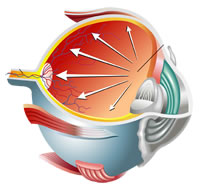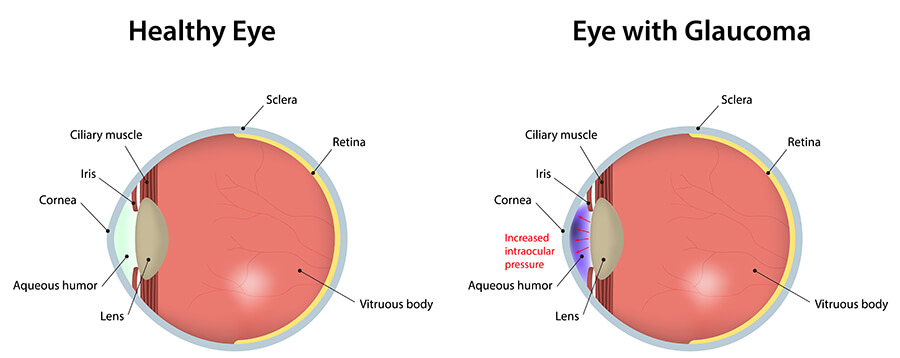What Is Glaucoma?
 Glaucoma refers to a group of diseases in which there is damage to the optic nerve, the nerve that exits the back of the eye and which sends signals to the brain that result in eyesight.
Glaucoma refers to a group of diseases in which there is damage to the optic nerve, the nerve that exits the back of the eye and which sends signals to the brain that result in eyesight.
Optic nerve damage typically occurs from elevated pressure inside the eye, but at least 20% of patients with glaucoma have a normal intraocular pressure (IOP).
Chronic open-angle glaucoma (COAG) is the most common form of glaucoma. It generally causes optic nerve damage over many years but once diagnosed, usually during a regular eye examination, glaucoma can be treated and severe vision loss averted.
There are no symptoms until very late in the course of glaucoma, which is why periodic eye examinations are so important for early detection and treatment. Since a normal IOP may not exclude glaucoma, other tests may be necessary to confirm a glaucoma diagnosis.
At Eastside Eye Associates, we have an advanced, ultramodern approach to glaucoma diagnosis, including tests showing corneal thickness, the appearance of the optic nerve, a visual field examination, and a computerized ultrasound of the optic nerve.
Once a diagnosis of glaucoma is made, treatment with eye drops, or in some cases laser, is started and the eye pressure is monitored on subsequent visits. Compliance with eye drops may be the single best way to avert serious vision loss.

Acute Angle-Closure Glaucoma
The “angle” of the eye is a tiny drainage area where the cornea meets the iris. In open-angle glaucoma the angle is open but the drain through which fluid passes is partially blocked, causing a gradual increase in IOP.
In narrow-angle glaucoma, the drain is open but the passageway for fluid to get to the drain is so narrow that fluid can get trapped in the eye, building up pressure fairly rapidly. In the United States, about two-thirds of glaucoma are open-angle and one third is narrow-angle.
Patients with a narrow-angle may be at risk for developing narrow-angle glaucoma, so a laser iridectomy may be needed to prevent angle-closure glaucoma.
Dr. Shulman routinely check a patient’s angle with a small mirror-like device called a gonioscope, and if we suspect that a patient may be at risk for this type of glaucoma, in-office laser treatment may be recommended.
If there is any suspicion of glaucoma of any kind, a thorough discussion with one of our doctors will generally point you in the right direction.





